NIST Smart Connected Systems Newsletter
February 2023
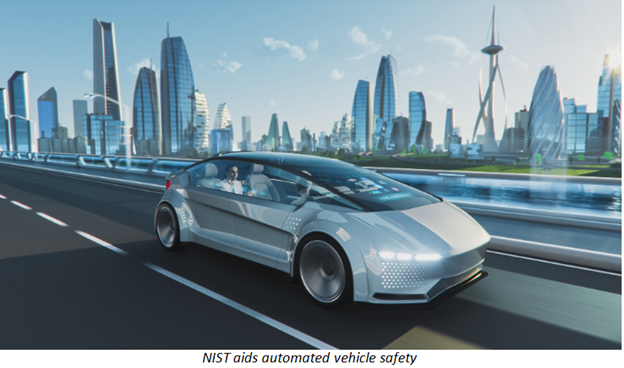
 NIST's Ed Griffor recently published a NIST Taking Measure blog, Cruising Toward Self-Driving Cars: Standards and Testing Will Help Keep Autonomous Vehicles Moving Safely on the Road, which addresses the challenges of automating vehicles and NIST's role in measuring and testing their performance.
Griffor noted that automating human driving is a tough engineering and safety challenge. Much of human driving is instinctual, he said, like stopping to avoid a deer. Human drivers also observe and communicate with other drivers and vulnerable road users, like cyclists and pedestrians, to ensure safety. Additionally, human drivers respond to traffic lights and signage. Moreover, we do not know enough about how to design and measure such automated performance and its safety.
And that is where NIST comes in, says Griffor. In several workshops and in the Automated Driving Systems Safety Measurement Technical Working Group, NIST interacted with stakeholders and developed a framework for measuring an automated vehicle's behaviors in its operating environment. Termed the Operating Envelope Specification, the framework provides metrics for operating conditions and behaviors such as lane change and navigating intersections. The framework supports stakeholders’ development and testing of automated vehicles.
NIST is also working to create a simulation platform for studying automated vehicle safety, which will address such issues as:
- Automated braking working in time to avoid collisions
- Automated vehicles obeying speed limits and other laws
- Automated vehicles safely passing other vehicles
Additionally, NIST identified the following research priorities, after asking stakeholders how it could further aid automated vehicle development:
- Interactions between systems in the vehicle
- Recognizing and responding to objects in the roadway
- Cybersecurity related to adversarial machine learning
- Automated vehicle communications
NIST's approach to automated vehicles and communications is described online. The NIST Automated Vehicle Program addresses system performance and measurement methods for key automated vehicle functions and technologies and provides for expanded stakeholder interactions, including a NIST workshop in September 2023. Ultimately, NIST seeks to facilitate development of methods and standards for nationwide automated vehicle testing.
Back to Top
 "The next pandemic is not a matter of if, but when," states the recently released, NIST Internal Report NIST IR 8437 On the Feasibility of COVID-19 Proximity Detection Using Bluetooth Low Energy Signals. The report addresses whether electronic devices – such as smartphones, wristbands – can instantaneously alert users when they are getting too close to others in a pandemic or if they have had close contact over a prescribed period of time in the past with those who have tested positive for a virus.
During the COVID-19 pandemic, NIST researchers assessed electronic devices for this ability, collecting Bluetooth Low Energy (BLE) Received Signal Strength Indicator (RSSI) data over several weeks. The electronic devices were developed at NIST and used Bluetooth and other technologies that can message nearby devices. Researchers tested the devices in varying radio frequency (RF) signal propagation scenarios, and developed various proximity detection methods and analyzed their performance.
NIST researchers reported that proximity detection based on BLE RSSI data does not work reliably. Proximity detection based on ultrasound and ultra wideband (UWB) RF signals hold much better promise. NIST has studied proximity detection based on ultrasonic signals and found that it can be quite effective with low false positive and false negative rates.
Back to Top
 Buildings consume approximately 74 % of the electricity sold in the U.S., but they also are increasingly storing and generating electricity, with batteries, solar panels, and more. Intelligent grid controls could help balance electricity demands with growing and distributed energy sources.
NIST researchers propose that the Transactive Energy concept could inform such intelligent grid controls in the recently published NIST Technical Note 2241, Comparison of Two Approaches for Managing Building Flexibility Using Energy Market Prices. The concept involves customers having a more immediate say about buying electricity (and even selling power to utilities).
To investigate this possibility, NIST researchers simulated and assessed two different Transactive Energy approaches which controlled cooling demand in the same houses, on the same grid, with the same weather.
- Real Time Control: One approach uses a controller that adjusts cooling based on real-time prices, while also accounting for house temperature, setpoint temperature, customer comfort, and previous day average price.
- Forecast-based Control: The other house uses a controller that determines the next day's optimal cooling setpoint based on forecasted hourly prices for the next day; this enables pre-cooling and avoidance of peak time prices.
Simulations showed that both controllers reduced electricity costs relative to a baseline for a fixed temperature setpoint. Forecast-based control can perform better by avoiding the multiple-hours of highest peak prices, but real-time control can save money when real-time prices are highly volatile.
However, both controller types induced power flow fluctuations, resulting in voltage fluctuations. On a more constrained grid, both types of controllers caused significant voltage violations, leading to reduced power quality, especially the real-time controller. On a more robust grid, these voltage fluctuations were significantly less. Analysis suggests that intelligent grid controls must be capable of managing jumps in power flow and voltage changes while still enabling customer flexibility – a subject of future NIST research.
Back to Top
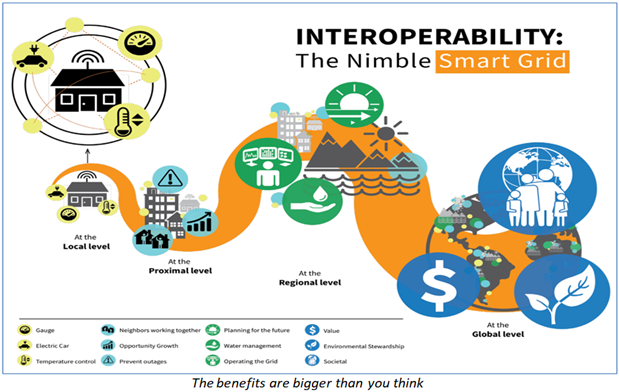 Interoperability initiatives could save the U.S. electric power industry at least $10 billion annually, reported The Benefits of Smart Grid Interoperability, authored by the National Association of Regulatory Utility Commissioners (NARUC) and NIST staff. The publication further states that grid interoperability's value is much greater than many estimate. Notably, interoperability aids:
-
Grid Resilience: Interoperability reduces outages; increases cybersecurity; and improves utility responses in weather-events.
-
Grid Safety: Interoperability reduces stress on systems; helps run assets more efficiently; and provides more visibility into operations and their cybersecurity.
-
Grid Affordability: Interoperability extends the life of assets by enabling them to meet changing demands; maintains functions while updating systems; and allows replacement of components instead of systems.
-
Grid Reliability: Interoperability improves system monitoring, operations, and power quality.
-
Policy: Grid Interoperability helps achieve social goals related to climate, energy, and access.
-
Economy: Grid Interoperability supports local, regional, and national economic growth.
-
Customers: Grid Interoperability allows customers to directly impact grid transformation; enables customer flexibility and customer-level resilience; and helps deploy systems that customers need.
The report provides examples of how grid interoperability has benefited stakeholders in Florida, Minnesota, Michigan, and Tennessee. It also lists publications on grid interoperability, issued by NIST, NARUC, and Gridwise/National Laboratories.
Back to Top
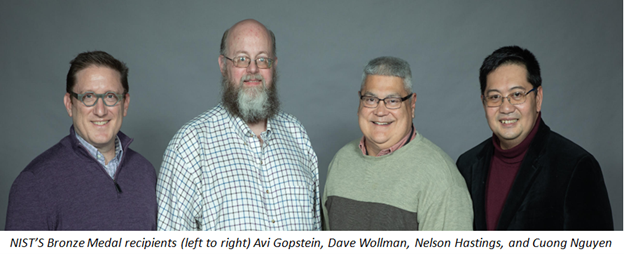 In January 2023, NIST awarded its Bronze Medal to Avi Gopstein, Nelson Hastings, Cuong Nguyen, and Dave Wollman for their development of the NIST Framework and Roadmap for Smart Grid Interoperability Standards, Release 4.0.
Following its release, one industry report called Framework 4.0, "required reading for utility grid technology architects, cyber professionals, and finance departments." Framework 4.0 noted that grid interoperability "creates new value throughout the smart grid," and addressed the potential values at the local, community, regional and global levels. The National Association of Regulated Utility Commissioners further expounded on these interoperability benefits.
Framework 4.0 also advanced the concept of "interoperability profiles" to achieve greater grid interoperability. It calls for focusing on what is needed to get multiple systems to work together – through an interoperability profile – in order to achieve a required function, like communications or cybersecurity. This approach has enabled:
Framework 4.0 also aided the Department of Commerce’s International Trade Administration with its assessment, Smart Grid Standards Adoption in Southeast Asia. The assessment used Framework 4.0 for a gap analysis of existing standards in the region. The assessment noted, "The Framework provides a useful conceptual model for smart grid applications." Power Grid International similarly stated that the model "supports a collective understanding of the actors, roles, and responsibilities needed to ensure effective day-to-day grid operations and control."
Notably, the award recipients express their great appreciation to NIST associate, Cheyney O'Fallon, who also made significant contributions to Framework 4.0.
Back to Top
NIST’s Global Community Technology Challenge (GCTC) leader, Michael Dunaway, gave the keynote presentation at MITRE's Smart City Summit, in January 2023, addressing the GCTC's future priorities. Dunaway described the GCTC as a collaboration platform for cities, communities, industry, academic, and government stakeholders, who seek emerging technologies for smart cities and communities. He then laid out the GCTC's goals for 2023-2025:
- Evolve into a national public-private partnership dedicated to the integration of advanced technologies for cities and communities.
- Develop a research-based scientific foundation for the GCTC and NIST Smart Cities Infrastructure program, with emphasis on communications technologies to enhance public safety, and community resilience.
- Broaden the definition of and agenda for smart cities and enable them to address cross-cutting challenges and achieve a more equitable distribution of benefits for residents and communities.
The goals were reported by MeriTalk, in NIST Lays Out Smart City Priority Goals for 2023-2025, January 12, 2023. It further reported that the GCTC expects to release a strategic plan in the coming months, which will detail how it will meet these goals.
Dunaway's presentation also was covered by GCN in Future-proofing smart cities with open standards, January 17, 2023. “The starting point is going to be an open-standards approach to development that offers the opportunity for future growth and expansion and evolution of digital transformation,” Dunaway told GCN. It is fundamental to future proofing, said Dunaway. It enables interoperability which could stave off obsolescence and keep a city’s infrastructure connected even as applications are added.
Back to Top
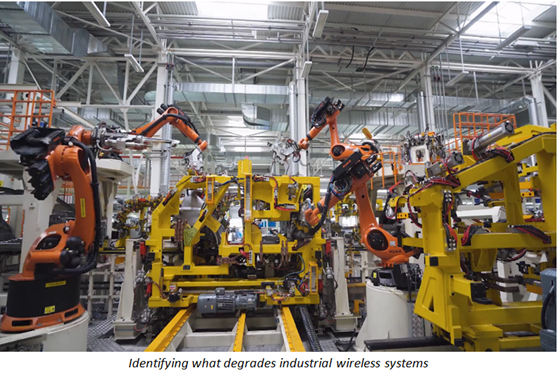 Researchers from Emerson Automation, Spearix Technologies, and NIST's Industrial Wireless Systems team recently assessed wireless factors – or "aggressors" – which could degrade the performance of industrial wireless systems. Emerson, a maker of factory automation technologies, and Spearix, a provider of industrial radio solutions, are actively involved in the NIST-chaired, IEEE P1451.5p Working Group, which seeks to develop a standard for assessing Industrial Wireless Systems.
Researchers conducted the tests at the NIST Gaithersburg campus, reproducing and assessing the impact of industrial wireless aggressors, which included:
- Multi-path propagation caused by large machinery
- Interference caused by Wi-Fi and Bluetooth signals from large cranes, microwave ovens, and variable speed drives
- Interference caused by Tungsten Inert Gas welding and arc welding
Researchers also assessed the impact of wireless aggressors on data packets, delivered via single- and multi-core radios. They found multi-core radios performs well in scenarios, which indicated potential advantages for industry. Researchers will report their findings to the IEEE P1451.5p Working Group.
Back to Top
 Many see millimeter-wave (mmWave) bands as having potential to provide machine-to-machine communications advancing industrial wireless systems. Compared to today's wireless bands, mmWave bands would enable larger bandwidth, higher directivity, improved signal reception, and increase efficient spectrum use.
At the 2022 Asilomar Conference on Signals, Systems, and Computers, the NIST Industrial Wireless Systems team, in collaboration with a Department of Defense researcher, introduced ways to improve the use of mmWave band in industrial wireless systems. Notably, the NIST and Defense researchers proposed ways to improve the testing and assessment of mmWave propagation and reception in machine-to-machine communications, based on research papers presented and published at the conference.
Improved Propagation: This approach is described in the paper, Wideband Synthetic Aperture Test Bed for Intelligent Reflecting Surfaces, and involves using synthetic aperture to accurately assess mmWave transmissions, which are strengthened and focused on a receiver, using adjustable small reflective units, called "Intelligent Reflecting Surfaces." Previously, the used beamforming at synthetic aperture did not account for the scattering of the beam's reflected energy. Researchers therefore developed a means for processing the synthetic aperture data to predict and account for the fields scattered from Intelligent Reflecting Surfaces.
Improved Reception: The approach described in the paper, Optimized Sparse Sampling Lattices, which was presented at the conference, involves using an algorithm to adjust an array of antennas such that they receive a focused mmWave beam, with less radiation lost to "sidelobes" – or radiation that is not received. The approach is designed to increase beam strength, reliability, and efficiency.
Back to Top
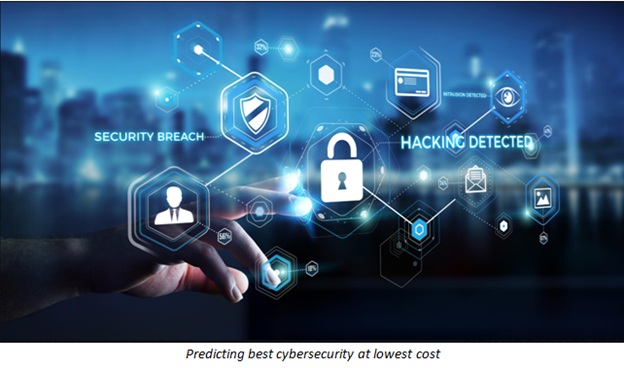 Previously, NIST researchers developed a model for predicting the minimum investment needed to achieve the optimum cybersecurity for large networks. Basically, it assessed security measures – such as monitoring, diagnostics, and more – against probabilities of breaching, rates of spreading, and recovery rates. Based on modeling results, algorithms determined the minimum investment needed for optimum cybersecurity. The model was described in Optimal Cybersecurity Investments in Large Networks Using SIS Model: Algorithm Design.
NIST researchers extended their work to very common situations for large networks, in their paper, Optimal Cybersecurity Investments Using SIS Model: Weakly Connected Networks, which was presented at the IEEE Global Communications Conference 2022. The previous model was based on assumptions that large networks were comprised of strongly connected networks, in which case infections can easily spread. However, many large networks consist of weakly connected networks, and thus the model and algorithms could not compute the optimal cybersecurity and the associated minimum investment.
Researchers, therefore, focused on addressing external attacks to weakly connected, large networks, again with the intent of minimizing cybersecurity costs. They found that these external attacks randomly occurred, but when they did, they continued and increased; this allowed researchers to compute the upper and lower bounds of this problem and thus solve it. In doing so, researchers extended their model's formulation to assessing the cybersecurity needed to address these external attacks and secondary attacks. Researchers also adapted their algorithms to predict the minimum investment needed for cybersecurity.
Back to Top
 When industry makes a product, all involved use information which digitally flows across the process to enable fast and accurate production. Information needs vary; for example, designers use geometric data, while manufacturers need tolerance data. Thus, the challenge is to digitally move "product and manufacturing information (PMI)," and enable different production systems to extract and use their requisite data.
To address this issue, the aerospace and automotive industries launched the PMI Project. This initiative updated applicable ISO and American Society of Mechanical Engineers standards, allowing ISO 10303 PMI models, which previously exchanged drawings and their information, to increase the exchange of information across lifecycle functions – design, fabrication, inspection. The PMI Project's development history, process, and data management were recently documented in NIST Advanced Manufacturing Series 100-51 On Migrating ISO 10303 PMI Models to a Common Core.
The NIST publication also provides other areas to be considered in future efforts to broaden the exchange of PMI across the production lifecycle. These include changing standards to address specifications for surface textures, edge conditions, welding, machining feature groups, statistical process controls, new shapes, and how more information related to drawing could be communicated.
Back to Top
|